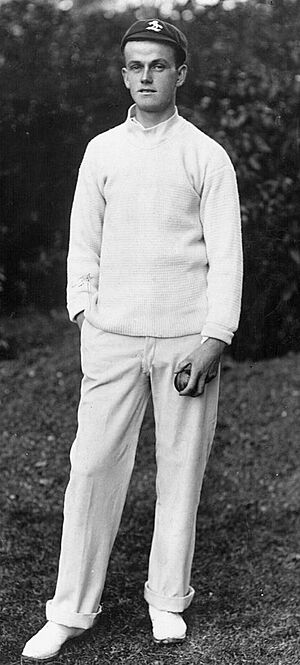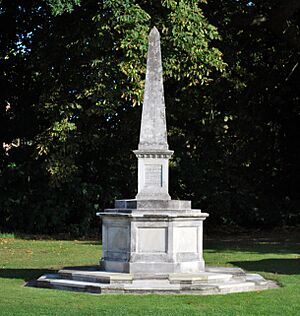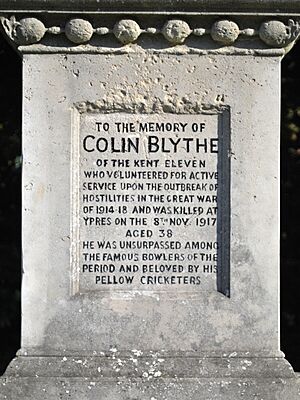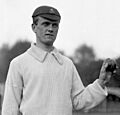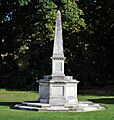Colin Blythe facts for kids

Blythe photographed by George Beldam in about 1905
|
||||||||||||||||||||||||||||||||||||||||
| Personal information | ||||||||||||||||||||||||||||||||||||||||
|---|---|---|---|---|---|---|---|---|---|---|---|---|---|---|---|---|---|---|---|---|---|---|---|---|---|---|---|---|---|---|---|---|---|---|---|---|---|---|---|---|
| Full name |
Colin Blythe
|
|||||||||||||||||||||||||||||||||||||||
| Born | 30 May 1879 Deptford, Kent, England |
|||||||||||||||||||||||||||||||||||||||
| Died | 8 November 1917 (aged 38) near Passendale, Belgium |
|||||||||||||||||||||||||||||||||||||||
| Nickname | Charlie | |||||||||||||||||||||||||||||||||||||||
| Batting | Right-handed | |||||||||||||||||||||||||||||||||||||||
| Bowling | Slow left arm orthodox | |||||||||||||||||||||||||||||||||||||||
| Role | Bowler | |||||||||||||||||||||||||||||||||||||||
| International information | ||||||||||||||||||||||||||||||||||||||||
| National side | ||||||||||||||||||||||||||||||||||||||||
| Test debut (cap 130) | 13 December 1901 v Australia | |||||||||||||||||||||||||||||||||||||||
| Last Test | 11 March 1910 v South Africa | |||||||||||||||||||||||||||||||||||||||
| Domestic team information | ||||||||||||||||||||||||||||||||||||||||
| Years | Team | |||||||||||||||||||||||||||||||||||||||
| 1899–1914 | Kent | |||||||||||||||||||||||||||||||||||||||
| Career statistics | ||||||||||||||||||||||||||||||||||||||||
|
||||||||||||||||||||||||||||||||||||||||
|
Source: CricInfo, 1 January 2021
|
||||||||||||||||||||||||||||||||||||||||
Colin Blythe (born 30 May 1879 – died 8 November 1917), also known as Charlie Blythe, was an English professional cricket player. He played Test cricket for the England cricket team in the early 1900s. Blythe was named a Wisden Cricketer of the Year in 1904. He took over 2,500 wickets in his career. This is a huge achievement, as only 13 players have ever done this!
Blythe was a slow left-arm orthodox bowler. Many people think he was one of the best left-arm spin bowlers in cricket history. He played for Kent County Cricket Club from 1899 to 1914. He holds a record for taking the most wickets in a single day's play, sharing it with two other famous bowlers. He took over 100 wickets in 14 of the 16 seasons he played. In 1909, he even took 215 wickets!
Even though he had epilepsy (a medical condition that causes seizures), Blythe joined the British army when World War I started. He sadly died during the Second Battle of Passchendaele while serving his country. There is a special memorial for him and other Kent cricketers who died in the war. It is at Kent's home ground, the St Lawrence Ground in Canterbury.
| Top - 0-9 A B C D E F G H I J K L M N O P Q R S T U V W X Y Z |
Early Life and Cricket Start
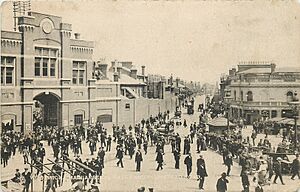
Colin Blythe was born on 30 May 1879 in Deptford, which was part of Kent back then. His family had moved there for work. His father, Walter, was an engineer. Colin was the oldest of thirteen children. He left school in April 1892, just before his 13th birthday. Deptford was a busy, industrial area at the time. Colin likely left school early to help his large family. He became an apprentice engineer, working with his father at the Royal Arsenal in Woolwich.
Colin wanted to study for a special scholarship. But the stress was bad for his health. A doctor suggested that fresh air would help him feel better. Until then, Colin hadn't played much organised cricket. He might have played for school or local clubs. But it seems he didn't start bowling seriously until he was at least 11.
His big break came on 17 July 1897. Colin, then 18, went to watch a county match between Kent and Somerset. There weren't many people watching. One of the Kent players, Walter Wright, needed someone to bowl to him for practice. Colin, being one of the few people there, offered to help.
William McCanlis, a former Kent cricketer and team coach, saw Colin bowl. He was very impressed by Colin's bowling style. McCanlis arranged for Colin to bowl for him again. McCanlis said finding Blythe was "a considerable amount of luck." Deptford wasn't a usual place to find cricket talent. Soon after, Colin bowled for McCanlis at his local club. He did so well that he was recommended for a trial at the Tonbridge Nursery. This was a special training place for young professional cricketers hoping to join the Kent team.
Colin passed the trial and joined the nursery for the 1898 season. The coaches wrote: "Bowls slow left. Very useful bowler." Colin continued to live at home and work as an engineer in the winter. But during the cricket season, he rented a room in Tonbridge. He did this until he got married in 1907.
Becoming a Kent Cricketer
Training at the Nursery
Colin Blythe spent the 1898 season at Tonbridge. This was probably the first time he had proper cricket coaching. The young players at the nursery practiced bowling every morning. In the afternoons, they practiced more or bowled to club members. They also played matches for local clubs. Colin quickly learned important cricket skills. These included bowling accurately and changing the flight and spin of the ball. These skills helped him throughout his career.
By 1899, he was playing regularly for local clubs. He bowled over 600 overs and took 105 wickets. This was much more than other bowlers at the nursery. His batting also got better. When he started, McCanlis said he had "no idea whatever" about batting.
First-Class Debut
In late August 1899, Colin, at 20 years old, was called up to the Kent team. He played his first first-class match against Yorkshire on 21 August 1899. Kent was having a tough season. Their bowlers hadn't been doing well. Kent started the match strongly, taking early wickets. Yorkshire began to recover. Colin was given the ball for the first time. With his very first ball in first-class cricket, he bowled out Frank Mitchell, who had scored 55 runs!
Colin played the last three games of the season. He took 12 more wickets. His best game was against Surrey. He took three wickets in each innings. The Times newspaper wrote that "Blythe, the new Kent left-hand slow bowler, seems a very promising man." Wisden Cricketers' Almanack, a famous cricket book, called him a "new and promising" bowler.
Becoming a Regular Player
In 1900, Colin played in all 22 of Kent's matches. He took 114 wickets and was Kent's best bowler. Kent finished third in the 1900 County Championship, their best finish in ten years. In his second match, he took five wickets in an innings against Gloucestershire. He took five wickets many more times that season.
During Canterbury Cricket Week, he took eleven wickets for 72 runs against Lancashire. The crowd cheered him and collected money for him. Both local and national newspapers praised his bowling. The Times said he had "bowled superbly." He had many more successes that season. He finished with 11 times taking five wickets in an innings and two times taking 10 wickets in a match.
Colin also benefited from Kent's new winter pay scheme for professional players. But the money wasn't enough to live on. So, he went back to work at the Woolwich Arsenal in the winter. He also lived with his family. He was sick for part of that winter. Kent told him to rest by the sea for two weeks. Some people think his illness might have been related to his epilepsy.
The weather in 1901 was very dry. This made the pitches hard, which was good for batting and not for Colin's bowling. He took fewer wickets that season (93 wickets). But when the conditions were right, he still did well. For example, he took seven wickets against Surrey. Even on good batting pitches, he made it hard for batsmen to score quickly. He didn't give away many runs.
Test Match Debut and Rising Star
First Tour to Australia
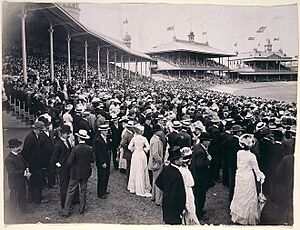
Colin's great performances led to him being chosen for an English team to tour Australia. This tour was led by Archie MacLaren. Two top English bowlers couldn't go, so MacLaren picked Colin and other promising players. Kent let Colin go on the tour but didn't pay him his winter wages. Colin seemed to enjoy the trip. He even played his violin with the ship's band!
In his first game in Australia, he took five wickets. He made his Test match debut on 13 December 1901. He took three wickets in the first innings and four in the second. The Times reported that he "bowled splendidly." England won that match. Colin was given a gold pocket watch for his great bowling.
He took four wickets in the second Test. But after that, his performance dropped. He only took six wickets in the last three Tests. This was because he split a finger on his left hand. Australian pitches didn't suit his bowling style either. Wisden said he worked hard, even with a weak bowling attack. He took 18 Test wickets. The tour actually helped his health, and he came back stronger.
Success in 1902
After the tour, Colin didn't need to train at the Tonbridge Nursery anymore. He had a very successful 1902 season. It was a wet summer, which meant lots of damp, rain-affected pitches. These conditions were perfect for his bowling. He took 127 wickets. This included his best figures so far: eight wickets for 42 runs against Somerset. He finished second in Kent's bowling averages. Even though he wasn't chosen to play for England against the touring Australians, The Times said his performance was "far in advance of anything he has previously done."
A Leading Cricketer
Growing Fame and Awards
Another wet summer in 1903 helped Colin's bowling. He took 142 first-class wickets. This was his best season yet for wickets and average. He was the "mainstay" (most important player) of Kent's bowling attack. By the end of the season, The Times called him "certainly one of the best slow medium left-handers at the present day."
Kent started the season badly. But they improved in August, when Colin took over 70 wickets. He took nine wickets in an innings against Essex. This was the first of six times he would take nine wickets in an innings. He had a string of successful games. He took 25 wickets in four innings over four days. Kent finished eighth in the Championship. Colin took at least one wicket in every match he played until August 1909. After the season, Kent toured the United States. Colin took ten wickets in two matches there.
In 1904, Wisden chose Colin as one of the Wisden Cricketers of the Year for his great performance in 1903. Wisden said "nothing stood out as prominently as the bowling of Blythe."
The summer of 1904 was drier. This meant fewer pitches suited Colin's bowling. He took 138 wickets. But he showed he could still do well on harder pitches. He could also slow down how quickly batsmen scored. In one match, he bowled for an hour without giving away a single run! He took thirteen wickets against Hampshire in June. Then he took fifteen wickets in a single day's play in August. This included nine wickets for 30 runs in the first innings.
He also started to show more skill as a batsman. He scored 82 not out against Nottinghamshire. He shared a partnership of 106 runs for the ninth wicket. He scored 70 runs in an hour against Somerset. In total, he scored 400 first-class runs, his best ever. His batting average reached 15.38. Some critics said he could have been a good batsman if he wanted. But he preferred hitting hard lower down the batting order. At the end of the season, The Times said he had "strong claims to be considered the best left-hander of his pace."
The next season, 1905, was his most successful yet. He took 149 wickets. Kent finished sixth in the County Championship. He also scored 75 runs in one game. The Australian team toured England that season. Wilfred Rhodes, England's main left-arm spin bowler, missed a Test match. Colin replaced him. This was his only Test match in England. He took four wickets. Wisden said he "bowled uncommonly well."
Second Overseas Tour and County Champions
Colin was chosen to tour South Africa in the winter of 1905–06. The English team wasn't very strong. Colin asked Kent to continue his winter pay, or he wouldn't go. The Kent committee agreed after a vote. In South Africa, Colin did very well. He took over 100 wickets in all games. He especially liked the matting pitches used there. He was one of the few English bowlers who did well in the Test matches. He played in all five matches and took 21 wickets. South Africa won the series. But in the only Test England won, Colin took eleven wickets in the match. This included his first five-wicket hauls in Test matches.
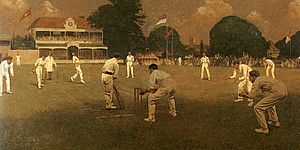
After finishing third in 1904 and sixth in 1905, Kent won the County Championship for the first time in 1906. Colin took 111 first-class wickets. But he was hurt, which stopped him from reaching 100 wickets in the Championship for the first time since 1901. He split a finger on his bowling hand and missed several games. While he was out, a 19-year-old player named Frank Woolley took his place. Woolley became one of Kent's greatest players.
Colin returned for the last eleven Championship matches. Kent won all of them to win the title. In a match against Surrey, he "won the game for Kent with some brilliant bowling." He took five wickets for 25 runs. Kent then needed only a draw in their final match to win the title. Colin took six wickets in each innings, and Kent won easily.
After their victory, the team was celebrated. The Kent Committee gave the professional players a bonus. They also asked an artist, Albert Chevallier Tayler, to paint one of the season's matches. The painting, Kent vs Lancashire at Canterbury, shows Colin Blythe as the bowler. It became very famous and is displayed at cricket grounds.
Great Seasons: 1907–1909
In a 1907 match against Northamptonshire, Kent won by a lot. The match was mostly about the weather and then about Colin Blythe. On the first day, Colin's 28th birthday, rain stopped play. On the second day, no play was possible. On the third day, Kent scored quickly. On a wet but drying pitch, Colin was amazing. He took 10 wickets for 30 runs! Northants had to bat again. Colin took seven more wickets. So, Colin took 17 wickets in a single day's play! Frank Woolley later said that Colin was unlucky not to take all twenty wickets in the match.
Colin's best Test bowling was eight wickets for 59 runs against South Africa in 1907. He took fifteen wickets in that whole match.
Kent didn't win the championship in 1907. But Colin had one of his best seasons. He took 183 wickets, the same as George Hirst. Only one bowler took more wickets than him. His average improved to 15.42. He took five wickets in an innings seventeen times and 10 wickets in a match six times.
Colin went on his second tour to Australia in 1907–08. He played in eleven matches and took 41 wickets. He took five wickets in an innings three times and 10 wickets in a match once.
Kent had a very good season in 1908, finishing second. Colin had an amazing season. He was the country's top wicket-taker for the first time, with 197 wickets. He took five wickets in an innings twenty times and 10 wickets in a match six times.
In 1909, Kent won the championship easily. Colin took 215 wickets, much more than anyone else. He was again the national leader. His average was 14.54. He took nine wickets in an innings once. He took five wickets in an innings 23 times and 10 wickets in a match seven times.
Later Career and War Service
Senior Professional Years
Colin went on his second tour of South Africa in 1909–10. He played in ten matches and took 50 wickets. He took seven wickets for 20 runs in one game.
He took two hat-tricks in his career. Both happened within two weeks in 1910. Kent won the championship again in 1910. Colin took 175 wickets. His average was 14.26. He took five wickets in an innings eighteen times and 10 wickets in a match four times.
In 1911, Kent finished second in the championship. Colin took 138 wickets. He took eight wickets for 45 runs in one game. He took five wickets in an innings ten times and 10 wickets in a match ten times.
Kent had another good season in 1912, finishing third. Colin had his best season in terms of statistics. He was both the top wicket-taker and had the best bowling average. He took 178 wickets. His best was eight wickets for 36 runs. He took five wickets in an innings sixteen times and 10 wickets in a match eight times.
In 1913, Kent won their fourth championship in eight seasons. Colin again had the best bowling average. He took 167 wickets. His best was seven wickets for 21 runs. He took five wickets in an innings fifteen times and 10 wickets in a match three times.
The Final Season and Military Service
When World War I started in August 1914, cricket continued. But people were less interested. Colin took ten wickets against Sussex and eight against Northants. In his final game at Canterbury, he took eleven wickets against Worcestershire. This included seven wickets for 20 runs to win the match for Kent. In his very last match, he took another seven wickets. At 35 years old, Colin finished the season as the top county wicket-taker with 170. But he didn't play Kent's final match. The war had changed everything.
| Allegiance | |
|---|---|
| Service/ |
|
| Years of service | 1914–1917 |
| Rank | Serjeant |
| Unit |
|
| Battles/wars | First World War
|
Even with his epilepsy, Colin joined the Kent Fortress Royal Engineers (KFRE) in late August. His Kent teammates and close friends joined too. As a trained engineer, Colin's skills were useful in the KFRE. He was promoted to corporal by the end of 1914 and to serjeant in 1915.
He spent the first years of the war working on coastal defenses. He also played cricket matches for the KFRE. In 1916, he played at Lord's and The Oval. In early 1917, Colin and his friend Claud Woolley were sent overseas. They were transferred to the Royal Engineers and trained. Colin played more cricket while training. His last matches at Lord's were against the Australian Imperial Forces. In his final match, he played for an Army and Navy team. He took one wicket, that of Australian international Charlie Macartney.
By this time, Colin knew he wouldn't be able to play cricket professionally after the war. He was hired as a cricket coach at Eton College. He planned to start that job after the war ended.
Colin was sent to the 12th battalion of the King's Own Yorkshire Light Infantry (KOYLI). This was a special battalion that built and maintained light railway lines. These lines helped move men, equipment, and supplies during the Battle of Passchendaele. On 8 November 1917, Colin and Claud Woolley were working on a railway line. A shell exploded, and a piece of shrapnel hit Colin in the chest, killing him instantly. The same explosion wounded Woolley.
Memorials
Colin Blythe is buried in the Oxford Road Commonwealth War Graves Commission Cemetery near Ypres. His headstone says, "In loving memory of my dear husband, the Kent & England cricketer."
A memorial for him and other Kent players who died in the war was put up at the St Lawrence Ground in Canterbury in 1919. It was first a drinking fountain. It was unveiled in August 1919. The first inscription had the wrong date for his death. It said 18th November, but he died on the 8th.
The memorial was moved during ground renovations. It was restored and rededicated in 2017, 100 years after his death. The inscription was corrected. Pelham Warner, who played with Colin, started a tradition of laying a wreath at the memorial. This tradition continues today.
Colin is also remembered with a mural in Tonbridge Parish Church. He is on the town's war memorial, and a road in Tonbridge is named after him. Two of Colin's wallets, torn by the shrapnel that killed him, are on display at the pavilion in Canterbury.
Playing Style and Technique
Colin Blythe was a talented violinist. Harry Altham, a cricket writer, said his slow left-arm bowling action was like a musician's touch. His left arm moved "in a long and graceful arc." Colin was a master of flight (how the ball moves through the air) and spin. He bowled very accurately. He used his fingers to make the ball either turn away from the batsman or swing inwards. These were very hard balls to hit on a pitch that helped bowlers. Even though he was a slow bowler, he sometimes bowled a faster "arm ball."
A. A. Thomson, another cricket writer, called Colin Blythe and Wilfred Rhodes "the greatest of slow left-hand bowlers." Thomson personally preferred Rhodes. But he admitted that many experts, including the famous batsman Ranjitsinhji, thought Colin was "the more difficult to play (against)." Many top batsmen respected Colin. Gilbert Jessop wrote that Colin was one of the bowlers he found hardest to face.
Colin is shown as the bowler in the famous painting Kent vs Lancashire at Canterbury. This painting was ordered by Kent to celebrate their first championship win in 1906. Lord Harris, a key figure in Kent cricket, insisted that Colin Blythe had to be the bowler in the painting. Altham wrote that Colin "stands out above his fellows as the greatest factor in the county's success."
Altham also said that Colin made bowling "a higher plane." He said Colin was "practically unplayable" on a "sticky wicket" (a damp, soft pitch). Altham explained that Colin's strengths were how quickly the ball would turn and rise from the pitch, along with his perfect accuracy.
Personal Life
Colin Blythe met Janet Gertrude Brown in 1906. She was from Royal Tunbridge Wells. She was ten years younger than Colin. They got married on 11 March 1907. They lived in Tonbridge, near the Angel Ground. They did not have any children. Before he was married, Colin lived with his family during the off-season. He continued to work as an engineer in the winters.
Colin was seen as a sensitive and artistic person. He was a talented violinist. Before his marriage, he played with a London music hall orchestra. Later, he played with the Tonbridge Symphony Orchestra. He loved classical music, especially by Brahms and Mozart.
Colin had epilepsy. Records of his condition started after his marriage in 1907. It's thought that the stress of his home life and cricket career might have made it worse. Altham said Colin was "utterly exhausted" after the 1907 Headingley Test, where he took 15 wickets.
Career Summary
Colin Blythe played first-class cricket for sixteen seasons, from 1899 to 1914. He played in 439 matches. He bowled over 100,000 balls. He took 2,503 wickets. His average was 16.81 runs per wicket. He took five wickets in an innings 218 times. He took 10 wickets in a match 71 times. He took 100 wickets in a season 14 times. His best bowling in one innings was 10 wickets for 30 runs in 1907. His best in a match was 17 wickets for 48 runs that same day.
As of 2017, Colin Blythe is one of only 33 players to have taken 2,000 first-class wickets. He is 13th on that list. But his career was much shorter than most of the players above him. Among bowlers with over 2,000 wickets, his average of 16.81 is the sixth best.
In Test cricket, Colin played for England 19 times between 1901 and 1910. He took exactly 100 wickets. His average was 18.63 runs per wicket. He took five wickets in an innings nine times and 10 wickets in a match four times. His best in an innings was eight wickets for 59 runs in 1907. His best in a match was 15 wickets for 99 runs.
As a batsman, Colin was not known for his batting. He usually batted low in the order. He scored 4,443 runs in his career. His average was 9.87 runs per dismissal. He never scored a century (100 runs) but did score five half-centuries (50 runs). His highest score was 82 not out. He was also a good fielder and took 206 catches. In Test matches, he scored 183 runs and took six catches.
Images for kids
-
The main gates of the Royal Arsenal at Woolwich around 1900. Blythe worked here after leaving school.
-
The Sydney Cricket Ground on the second day of Blythe's first Test match, 14 December 1901.
-
Kent vs Lancashire at Canterbury, a painting showing Blythe as the bowler.


